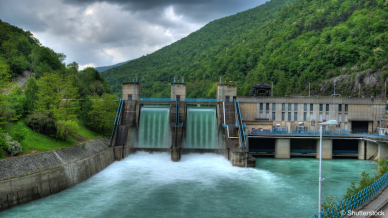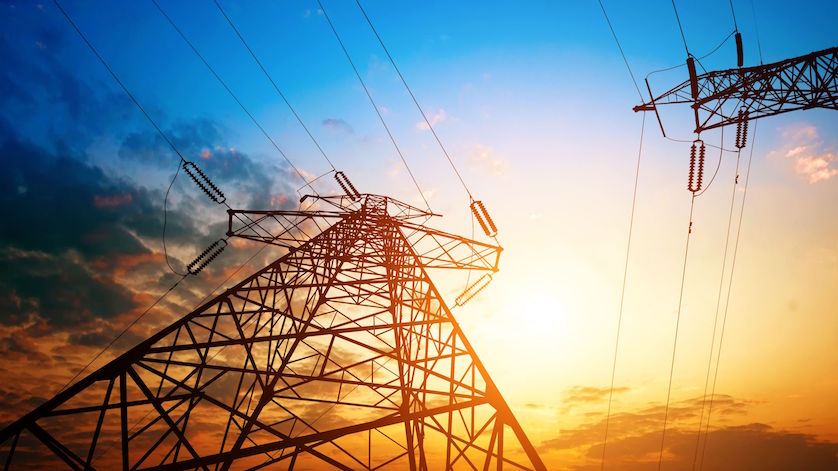
Pumping systems in a power plant use a significant percentage of a facility’s energy. To save money, improve efficiency, and prolong the machines’ lifetime, a power station should constantly monitor the flow, pressure, and temperature in industrial pumping systems.
Pumps are critical components in all types of power plants – combined cycle gas turbine (CCGT), coal, and hydroelectric. In a typical CCGT plant, there could be anywhere from 20 to 30 medium- to large-size pumps.If a critical pumping function is lost, a unit will most likely have to shut down. Pumps are so important that there are often duplex and even triplex installations as backups in critical applications, ready to switch over at a moment’s notice.
These vital pieces of expensive equipment require constant monitoring to prevent damage and downtime. An easy and cost-effective way to monitor industrial pumps is to install sensors and transmitters – relatively modest investments – at critical points. For example, spending a few hundred dollars on measuring instruments can protect a very expensive pump from serious harm caused by dry running or other situations.
Monitoring Pumping Systems for Safety, Performance, and Savings
WIKA designs and manufactures a variety of sensors, transducers, and transmitter for monitoring pressure, flow, and temperature. Here is an overview of the critical measuring points and how WIKA’s instruments protect industrial pumps:
Pressure at the suction side, to prevent cavitation
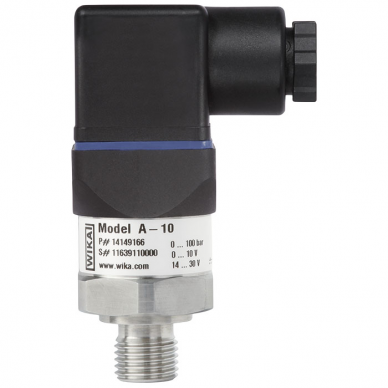
Model A-10 Pressure Transmitter for general industrial applications
Cavitation is the generation of vapor bubbles, which occur in high-velocity liquids. When these bubbles collapse, the result is pressure spikes. Cavitation can also occur if the local pressure drops below the vapor pressure of the liquid and then rises above it. To avoid this condition, thenet possible suction head available (NPSHa) has to be greater than the net possible suction head required (NPSHr).
Monitoring the suction head (pressure in terms of water column) can help identify problems that damage pumps. The A-10 pressure transmitter features a piezoelectric sensor and thin-film technology, making it highly resistant to pressure spikes and vibration. It has an all-welded stainless steel measuring cell and does not need any soft sealing. A variety of available electrical process connections meet the requirements of almost any application.
Flow at the suction side, to signal low fluid levels that can result in dry runs and dead heads
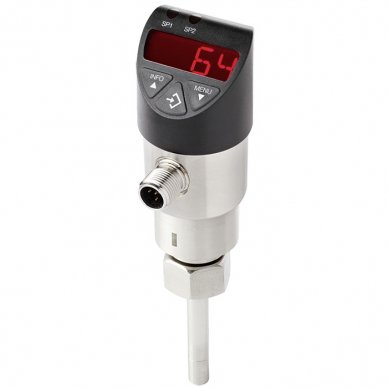
Model FSD-3 electronic flow switch
A pump is “dry running,” or in a near-empty pipe condition, when the suction side doesn’t receive enough fluid. When the pump operates with no flow at all, it is“dead-headed.” Both conditions can cause the pump to overheat and fail.
Ideal for monitoring cooling systems, the FSD-4 electronic flow switch provides switching and analog outputs for flow, temperature, and diagnostics. It has been designed with no moving parts in the medium, which makes it free from wear and tear. A simple and intuitive navigation menu makes operation easy, and a large LED display allows clear readings from a distance.
Pressure at the discharge side, to ensure proper operations
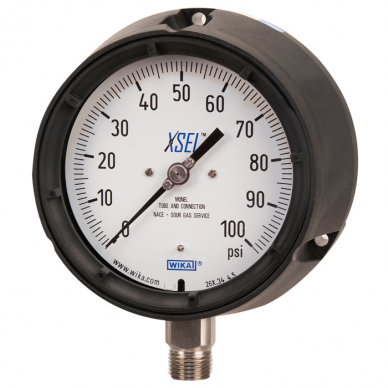
XSEL® process gauge
Both underpressure and overpressure on the outlet side reduce a power plant’s efficiency. All XSEL® models – 22X.34, 23X.34, and 26X.34– feature a Bourdon tube design and movement with hardened components that reduce stress and wear. The innovative XSEL® process pressure gauge exceeds pressure gauge performance testing standards ASME B40.100 and EN 837-1. And it’s safer, too: The XSEL® has a fire-resistant case according to flammability rating UL 94, V-0 test procedures. All XSEL® process pressure gauge movements are Swiss made, producing the most precise and reliable movements available today. WIKA’s industry-best warranty on all XSEL® process pressure gauges include a standard five-year warranty on the pressure gauge and a 10-year warranty on the pressure system. The XSEL® process gauge sets a standard of value as well: It is an economical solution for most processing applications since it reduces downtime from having to regularly replace worn-out instruments.
Fluid level at seal pots, to prevent the discharge of toxic, hazardous, or corrosive fluids
Some pumping systems deal with toxic, hazardous, or corrosive fluids, which must not leak into the environment. In these cases, the pump has a double seal (tandem seal) with a compatible liquid injected into a seal chamber to serve as a barrier fluid. If any dangerous liquids leak across the inner seal (primary seal), it enters the seal chamber and mixes with the barrier fluid. A loss of fluid could cause the seal assembly to fail and for dangerous products to be released into the environment.
Supplying the double-seal assembly with clean, pressurized barrier fluid is the seal pot. This vessel can also be used to measure the flow of high-density and corrosive media to protect differential pressure measuring instruments from these media.

Model WPS SR4 electric level control switch
Seal pots have a high-level or low-level liquid switch, although some applications call for both types. The WPS SR4 electric level control switch has wetted parts made of 316 stainless steel for extra corrosion resistance. Its hermetically sealed switch cartridge protects the integrity of switch contacts, which can control both high and low liquid levels. The working pressure of this float-actuated pneumatic switch is 1,500 to 5,000 psig.
Temperature at the bearings, to prevent overheating
A change in the bearing temperature of a pump and/or motor can indicate a developing failure or a change in loading. The compact TR58 bearing RTD sensor is designed for areas where space is an issue. It uses thin-film technology and responds extremely fast. With no moving parts, it is vibration resistant and perfect for measuring temperature in thrust bearing plates, shafts, and motor windings. The TR58 can be spring loaded into the bearings’ housing or held in position with a high temperature epoxy resin.
Differential temperature and pressure between the suction and the discharge fluid, to assess pump efficiency
To make sure a pump is working at optimal capacity, technicians can place highly accurate temperature sensors and pressure transmittersat both the suction and discharge sides. If the pump isn’t operating as efficiently as it can be, there will be a drop in pressure and temperature. This is thermodynamic monitoring, which does not require measuring the actual flow rate to determine efficiency.
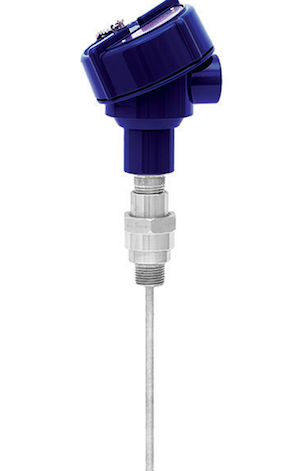
Model TR10 RTD sensor
The A-10 pressure transmitter is precision engineered for excellent performance. The standard model has a non-linearity (BFSL) of ≤±0.5% of span, and there’s an option for ≤±0.25% of span. This versatile and ruggest transmitter can withstand a wide range of temperature and pressure conditions, as well as the extreme shock and vibrations found in power plants.
The TR10 series of RTD sensors can be mounted into a thermowell, or directly into the process with a spring-loaded compression fitting for easy installation and replacement. The TR10 has the option of a transmitter to convert the resistance signal into an analog or a digital output, which can be easily customized to a variety of conditions.
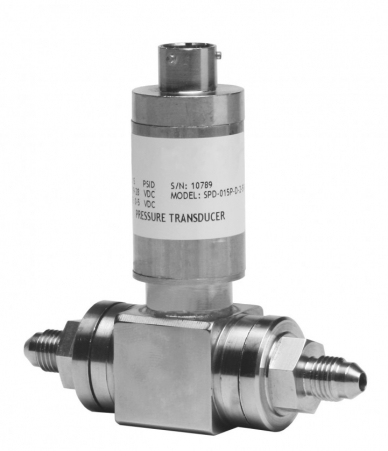
Model SP007 configurable differential pressure transducer
Differential pressure at filters and strainers, to assess debris accumulation
If pressure drops at the discharge side, that’s a good indication the strainer or filter needs to be cleaned or replaced. Monitoring the pressure differential between the inlet and outlet of a pump can also indicate overall efficiency and help identify conditions where cavitation is likely to occur.
The SP007 differential pressure transducer is fully configurable. Users have a choice of six pressure ports, five electrical connections, and a voltage or current output to match the needs of their applications. The SP007 has a standard accuracy of 0.25% and an optional high accuracy of 0.1%.
WIKA, Your Trust Partner in Measurement Technology
WIKA USA offers a comprehensive portfolio of high-quality instruments for monitoring the operations of industrial pumps. The right model will depend on your particular application, preferences, and desired price range. Contact our experts in power generation and industrial machines for more information on how we can help protect your facility’s valuable and hardworking equipment.
Be sure to read the first article in this two-part series, Industrial Pumps: The Beating Heart of a Power Plant.
Click here to view the white paper “Monitoring Safety & Efficiency: The Importance of Measuring Level, Flow, Pressure, Temperature, and Force in Hydropower Plants”
